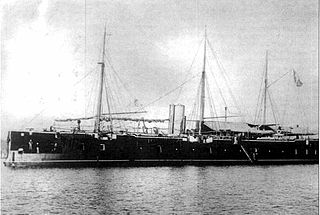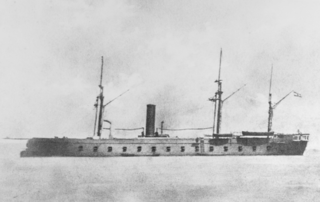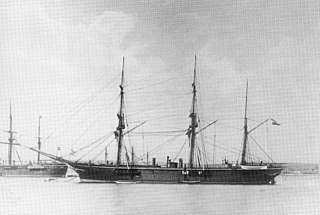
SMS Frundsberg was an Austro-Hungarian corvette built by Stabilimento Tecnico Triestino.

SMS Kaiser was a 92-gun wooden ship of the line of the Austrian Navy, the last vessel of the type, and the only screw-driven example, to be built by the Austrians. She was built by the naval shipyard in Pola; she was laid down in March 1855, was launched in October 1858, and was completed the following year. The ship took part in the Second Schleswig War of 1864, but saw no action during her deployment to the North Sea. Kaiser did see action during the Seven Weeks' War two years later, during which she took part in the Battle of Lissa as the flagship of Anton von Petz, commander of the Austrian 2nd Division. Kaiser engaged several Italian ironclads simultaneously, rammed one—Re di Portogallo—and damaged another—Affondatore—with gunfire. In doing so, she became the only wooden ship of the line to engage an ironclad warship in battle.

SMS Salamander was a Drache-class armored frigate built for the Austro-Hungarian Navy in the 1860s; she was laid down in February 1861, launched in August that year, and completed in May 1862, six months before her sister Drache. She was a broadside ironclad, mounting a battery of twenty-eight guns in gun ports along the length the hull. During the Second Schleswig War in 1864, Salamander remained in the Adriatic to protect Austria from a possible Danish attack that did not materialize. Two years later, during the Seven Weeks' War, she participated in the Austrian victory over a superior Italian fleet in the Battle of Lissa in July 1866. Immediately after the war, she was modernized with a battery of more powerful guns. Little used thereafter owing to reduced naval budgets, she was stricken from the Navy List in 1883 and hulked for use as a mine storage ship before being broken up in 1895–1896.

Roma was an ironclad warship built for the Italian Regia Marina in the 1860s; she was the lead ship of the Roma-class ironclads. Armed with a main battery of five 254 mm (10 in) and twelve 203 mm (8 in) guns in a broadside arrangement, Roma was obsolescent by the time she entered service. As a result, her career was limited. In 1880, she took part in an international naval demonstration off Ragusa to enforce the Treaty of Berlin. In November 1881, she collided with the ironclad Principe Amedeo in a storm in Naples, but she was not damaged. Roma was reduced to a guard ship in 1890 and then to a depot ship in 1895. In July 1896, she was scuttled to save the ship from a fire caused by a lightning strike. She was thereafter raised and broken up for scrap.

Venezia was the second of two Roma-class ironclad warships built for the Italian Regia Marina in the 1860s. She was armed with a main battery of eighteen 254 mm (10 in) guns in a central armored casemate. Her lengthy construction time, a result of her re-design from a broadside ironclad, quickly rendered her obsolescent compared to the new turret ships that began to enter service in the 1880s. As a result, her career was limited. She became a training ship in 1881 and served until 1895. Venezia was broken up for scrap the next year.

San Martino was a Regina Maria Pia-class ironclad warship, the second member of her class. She was built for the Italian Regia Marina in the 1860s; like her three sister ships, she was built in France. San Martino was laid down in July 1862, was launched in September 1863, and was completed in November 1864. The ships were broadside ironclads, mounting a battery of four 203 mm (8 in) and twenty-two 164 mm (6.5 in) guns on the broadside.

Formidabile was the lead ship of the Formidabile-class ironclad warships, the first ships of that type to be built for the newly formed Italian Regia Marina. Formidabile and her sister, Terribile, were both built in France; Formidabile was laid down in December 1860, was launched in October 1861, and was completed in May 1862. She was a broadside ironclad, equipped with four 203 mm (8 in) and sixteen 164 mm (6.5 in) guns.

SMS Lissa, named for the Battle of Lissa, was a unique ironclad warship built for the Austro-Hungarian Navy in the 1860s and 1870s, the only member of her class. She was the first casemate ship built for Austria-Hungary, she was armed with a main battery of twelve 9-inch (229 mm) guns in a central armored casemate, unlike the earlier broadside ironclads. Construction of the ship lasted from June 1867 to May 1871, and was delayed by budgetary shortfalls; the lack of funding also plagued the ship during her career, preventing her from taking an active role in the fleet. She spent the majority of her time in service laid up in Pola, apart from a lengthy reconstruction in 1880–1881. Lissa was ultimately stricken from the fleet in 1892 and broken up for scrap starting the following year.

SMS Erzherzog Ferdinand Max was the lead ship of the Erzherzog Ferdinand Max class of broadside ironclads built for the Austrian Navy in the 1860s. She was built by the Stabilimento Tecnico Triestino, with her keel laying in October 1863, launching in May 1865, and commissioning in June 1866 at the outbreak of the Third Italian War of Independence and the Austro-Prussian War, fought concurrently. The ship was armed with a main battery of sixteen 48-pounder guns, though the rifled guns originally intended, which had been ordered from Prussia, had to be replaced with old smoothbore guns until after the conflicts ended.

SMS Habsburg was the second and final member of the Erzherzog Ferdinand Max class of broadside ironclads built for the Austrian Navy in the 1860s. She was built by the Stabilimento Tecnico Triestino; her keel was laid down in June 1863, she was launched in June 1865, and commissioning in June 1866 at the outbreak of the Third Italian War of Independence and the Austro-Prussian War, fought concurrently. The ship was armed with a main battery of sixteen 48-pounder guns, though the rifled guns originally intended, which had been ordered from Prussia, had to be replaced with old smoothbore guns until after the conflicts ended.

SMS Kaiser Max was the lead ship of the Kaiser Max class of armored frigates built for the Austrian Navy in the 1860s. Her keel was laid in October 1861 at the Stabilimento Tecnico Triestino shipyard; she was launched in May 1862, and was completed in 1863. She carried her main battery—composed of sixteen 48-pounder guns and fifteen 24-pounders—in a traditional broadside arrangement, protected by an armored belt that was 110 mm (4.3 in) thick.

SMS Radetzky was a screw frigate in the Austro-Hungarian Navy, built in England in 1856. She was lost after the detonation of her powder magazine in 1869.

SMS Zrinyi was a screw corvette of the Aurora class and was built for the Austro-Hungarian Navy in the early 1870s.

SMS Fasana was a screw corvette of the Austro-Hungarian Navy built in the late 1860s and early 1870s, the only member of her class.
SMS Helgoland was a screw corvette of the Austro-Hungarian Navy built in the late 1860s. She was the only member of her class.

SMS Erzherzog Friedrich was a screw corvette of the Austrian Navy, and was built in the 1850s. She was the lead ship of the Erzherzog Friedrich class, the first vessels of that type built for the Austrian fleet. She had one sister ship, Dandolo.

SMS Dandolo was the second and final member of the Erzherzog Friedrich class of screw corvettes built for the Austrian Navy in the 1850s.
SMS Donau was a screw frigate, the last of the three vessels of the Radetzky class that were built for the Austrian Navy in the 1850s.

SMS Schwarzenberg was a frigate of the Austrian Navy, built in the 1850s, the only member of her ship class. She was converted into a screw frigate in the early 1860s. Schwarzenberg saw significant action during her career, leading the Austro-Prussian squadron at the Battle of Heligoland in the 1864 Second Schleswig War and participating in the Battle of Lissa during the Third Italian War of Independence.

SMS Radetzky was a screw frigate of the Austro-Hungarian Navy; she was the lead ship of the Radetzky class, which also included SMS Laudon. The ship was built in the early 1870s.


















